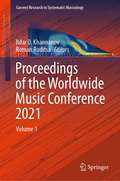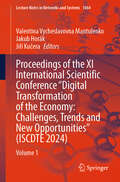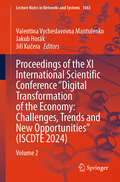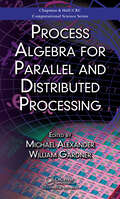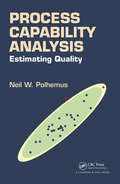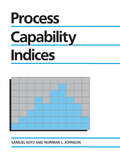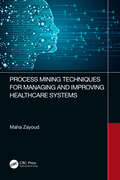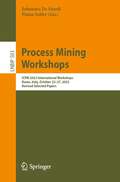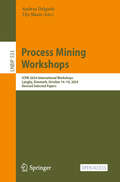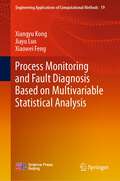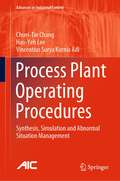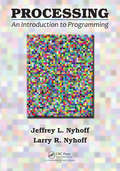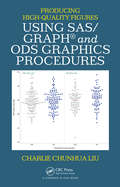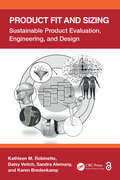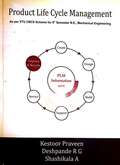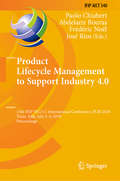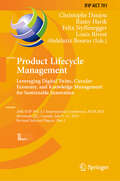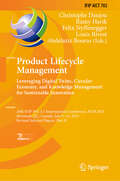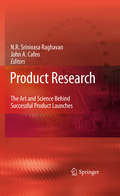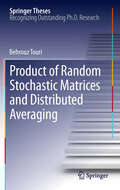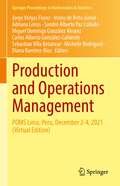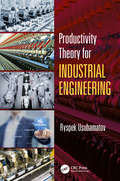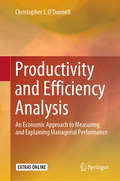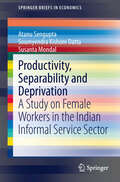- Table View
- List View
Proceedings of the Worldwide Music Conference 2021: Volume 1 (Current Research in Systematic Musicology #8)
by Ildar D. Khannanov Roman RuditsaThis book presents sixteen chapters in Volume 1. This Volume I of the Proceedings of the Worldwide Music Conference 2021 offers a smorgasbord of scientific approaches to music. The congress is one of a kind; it is dedicated not to a specific field but to the interdisciplinary developments and the interaction with the representatives from actual scientific disciplines. The languages of mathematics, computer science, semiotics, palaeography, and medicine are in the mix; geography of the studies is also impressive—Greece, Mexico, China, Russia, India, Poland, and USA, to name just a few. The purpose of such juxtaposition is to see how the terminology, categorical apparatus, and interpretations of music vary from science to science and how this can enrich the terminology of music theory. They cover a wide range of topics that the editors divided into four subfields: music in interdisciplinary contexts, music and current technology, musical instruments and voice, and music pedagogy and medicine. The opening section of the Proceedings is thus dedicated to the idea of interdisciplinarity, relationship of creator of theory of harmony Rameau to sciences of his time, the idea of number in music, co-creation, and the category of musical network. Three more chapters here deal with Russian palaeography, Indian musical genre, and the idea of musical semiotics. It is a kind of opening statement from music theorists. Part two, music and current technology, united three chapters, on “zero gravity” concept in modern music, discussion of scales as mathematical networks, and the innovation in digital music making, transforming it from stationary to mobile applications. The third part, musical instruments and voice, is of special interest because it is in the study of the instruments, the design, acoustic characteristics, and tuning, and sciences have cooperated with music theory for centuries. In addition to instruments, one chapter here is dedicated to voice. The last part, musical pedagogy and medicine, takes the reader even further into the interdisciplinary domain. The Proceedings is written in standard English language, prepared for the pleasure of reading of wide circles of professionals in different fields. The purpose of the editors is to bring this rather diverse set of texts into the context of a fruitful dialogue.
Proceedings of the XI International Scientific Conference "Digital Transformation of the Economy: Volume 1 (Lecture Notes in Networks and Systems #1064)
by Jakub Horák Valentina Vycheslavovna Mantulenko Jiří KučeraThis book includes selected reports of the XI International Scientific Conference “Digital Transformation of the Economy: Challenges, Trends and New Opportunities” (ISCDTE 2024), Samara, Russia. The proceedings volumes present the latest research on the digital transformation of the economy, its challenges, trends and new opportunities. The conference mainly focused on issues of the digital transformation, such as the theoretical background for the development of socio-economic systems in the digital age and specific practical issues related to actual business practices. Consisting of 8 chapters corresponding to the thematic areas of the conference, and written by scientists and practitioners from different regions, the book offers answers to the most pressing questions for contemporary business, research, engineering and education community from the perspective of the new reality.
Proceedings of the XI International Scientific Conference "Digital Transformation of the Economy: Volume 2 (Lecture Notes in Networks and Systems #1063)
by Jakub Horák Valentina Vycheslavovna Mantulenko Jiří KučeraThis book includes selected reports of the XI International Scientific Conference “Digital Transformation of the Economy: Challenges, Trends and New Opportunities” (ISCDTE 2024), Samara, Russia. The proceedings volumes present the latest research on the digital transformation of the economy, its challenges, trends and new opportunities. The conference mainly focused on issues of the digital transformation, such as the theoretical background for the development of socio-economic systems in the digital age and specific practical issues related to actual business practices. Consisting of 8 chapters corresponding to the thematic areas of the conference, and written by scientists and practitioners from different regions, the book offers answers to the most pressing questions for contemporary business, research, engineering and education community from the perspective of the new reality.
Process Algebra for Parallel and Distributed Processing
by William Gardner Michael AlexanderCollects the Latest Research Involving the Application of Process Algebra to ComputingExploring state-of-the-art applications, Process Algebra for Parallel and Distributed Processing shows how one formal method of reasoning-process algebra-has become a powerful tool for solving design and implementation challenges of concurrent systems. Parallel Pr
Process Capability Analysis: Estimating Quality
by Neil W. PolhemusProcess Capability Analysis: Estimating Quality presents a systematic exploration of process capability analysis and how it may be used to estimate quality. The book is designed for practitioners who are tasked with insuring a high level of quality for the products and services offered by their organizations. Along with describing the necessary statistical theory, the book illustrates the practical application of the techniques to data that do not always satisfy the standard assumptions. <P><P> The first two chapters deal with attribute data, where the estimation of quality is restricted to counts of nonconformities. Both classical and Bayesian methods are discussed. The rest of the book deals with variable data, including extensive discussions of both capability indices and statistical tolerance limits. Considerable emphasis is placed on methods for handling non-normal data. Also included are discussions of topics often omitted in discussions of process capability, including multivariate capability indices, multivariate tolerance limits, and capability control charts. A separate chapter deals with the problem of determining adequate sample sizes for estimating process capability. <P><P> Features: <li> Comprehensive treatment of the subject with consistent theme of estimating percent of nonconforming product or service. <li> Includes Bayesian methods. <li> Extension of univariate techniques to multivariate data. <li> Demonstration of all techniques using Statgraphics data analysis software. <P><P> Neil Polhemus is Chief Technology Officer at Statgraphics Technology and the original developer of the Statgraphics program for statistical analysis and data visualization. Dr. Polhemus spent 6 years on the faculty of the School of Engineering and Applied Science at Princeton University before moving full-time to software development and consulting. He has taught courses dealing with statistical process control, design of experiments and data analysis for more than 100 companies and government agencies.
Process Capability Indices: A Comprehensive Exposition Of Quality Control Measures (Series On Quality, Reliability And Engineering Statistics #Vol. 12)
by Samuel Kotz Norman L. JohnsonA solid, rigorous, yet comprehensible analysis of process capability indices, this work bridges the gap between theoretical statisticians and quality control practitioners, showing how an understanding of these indices can lead to process improvement.
Process Mining Techniques for Managing and Improving Healthcare Systems
by Maha ZayoudThis book discusses a new process mining method along with a detailed comparison between different techniques that provide a complete vision of the process of data acquisition, data analysis, and data prediction. Process Mining Techniques for Managing and Improving Healthcare Systems offers a new framework for process learning which is probabilistic and enables the process to be learned in an accumulative manner. The steps of prediction modeling and building the required knowledge are highlighted throughout the book, along with a strong emphasis on the correlation between the healthcare domain and technology including the different aspects, such as: managing records, information, and procedures; early detection of diseases; and the improvement of accuracy in choosing the right treatment procedures. This reference provides a wealth of knowledge for practitioners, researchers, and students at the basic and intermediary levels working within the healthcare system, computer science, electronics and communications, as well as medical providers and also hospital management entities.
Process Mining Workshops: ICPM 2023 International Workshops, Rome, Italy, October 23–27, 2023, Revised Selected Papers (Lecture Notes in Business Information Processing #503)
by Pnina Soffer Johannes De SmedtThis volume constitutes the revised selected papers of several workshops which were held in conjunction with the 5th International Conference on Process Mining, ICPM 2023, held in Rome, Italy, in October 23–27, 2023.The 38 revised full papers presented in this book were carefully reviewed and selected from 85 submissions. The book also contains one invited talk. ICPM 2023 presented the following six workshops:– 4th International Workshop on Event Data and Behavioral Analytics (EdbA)– 4th International Workshop on Leveraging Machine Learning in Process Mining (ML4PM)– 6th International Workshop on Process-Oriented Data Science for Healthcare (PODS4H)– 8th International Workshop on Process Querying, Manipulation, and Intelligence (PQMI)– 2nd International Workshop on Education Meets Process Mining (EduPM)– 2nd International Workshop on Collaboration Mining for Distributed Systems (COMINDS).
Process Mining Workshops: ICPM 2024 International Workshops, Lyngby, Denmark, October 14–18, 2024, Revised Selected Papers (Lecture Notes in Business Information Processing #533)
by Andrea Delgado Tijs SlaatsThis book constitutes the revised accepted papers of several workshops which were held in conjunction with the 6th International Conference on Process Mining, ICPM 2024, held in Lyngby, Denmark, during October 2024. The 56 revised full papers presented in this book were carefully reviewed and selected from 126 submissions. The papers presented in this volume stem from the following workshops: – 9th International Workshop on Process Querying, Manipulation, and Intelligence (PQMI) – 3rd International Workshop on Education Meets Process Mining (EduPM) – 3rd International Workshop on Collaboration Mining for Distributed Systems (CoMinDS) – 5th International Workshop on Leveraging Machine Learning in Process Mining (ML4PM) – 5th International Workshop on Event Data and Behavioral Analytics (EdbA) – 7th International Workshop on Process-Oriented Data Science for Healthcare (PODS4H) – 1st International Workshop on Empirical Research in Process Mining (ERPM) – 1st International Workshop on Generative Artificial Intelligence for Process Mining (GenAI4PM) – 4th International Workshop on Stream Management & Analytics for Process Mining (SMA4PM) – 1st International Workshop on Process Mining for Sustainability (PM4S).
Process Monitoring and Fault Diagnosis Based on Multivariable Statistical Analysis (Engineering Applications of Computational Methods #19)
by Xiangyu Kong Jiayu Luo Xiaowei FengThis book reports the developments of the Total Least Square (TLS) algorithms for parameter estimation and adaptive filtering. Specifically, this book introduces the authors’ latest achievements in the past 20 years, including the recursive TLS algorithms, the approximate inverse power iteration TLS algorithm, the neural based MCA algorithm, the neural based SVD algorithm, the neural based TLS algorithm, the TLS algorithms under non-Gaussian noises, performance analysis methods of TLS algorithms, etc. In order to faster the understanding and mastering of the new methods provided by this book for readers, before presenting each new method in each chapter, a specialized section is provided to review the closely related several basis models. Throughout the book, large of procedure of new methods are provided, and all new algorithms or methods proposed by us are tested and verified by numerical simulations or actual engineering applications. Readers will find illustrative demonstration examples on a range of industrial processes to study. Readers will find out the present deficiency and recent developments of the TLS parameter estimation fields, and learn from the the authors’ latest achievements or new methods around the practical industrial needs. In my opinion, this book can be assimilated by advanced undergraduates and graduate (PH.D.) students, as well as statisticians, because of the new tools in data analysis, applied mathematics experts, because of the novel theories and techniques that we propose, engineers, above all for the applications in control, system identification, computer vision, and signal processing.
Process Plant Operating Procedures: Synthesis, Simulation and Abnormal Situation Management (Advances in Industrial Control)
by Chuei-Tin Chang Hao-Yeh Lee Vincentius Surya AdiProcess Plant Operating Procedures presents an introduction to the theory and applications of procedure synthesis that is primarily concerned with the task of conjecturing the sequence of controller (or operator) actions needed to achieve designated operational goals in a given system. In order to facilitate practical implementation, the formal problem statement, two alternative approaches, their validation methods and a series of realistic examples are provided. The authors explore Petri nets and automata to identify the best paths leading to the specified goal of operation. The model-building methods for characterising all components in the given system, as well as the required control specifications, are explained with simple examples. The sequential control actions and the corresponding time schedule can then be identified accordingly. This book exposes practitioners to an important area of plant operations, teaching them effective approaches for procedure synthesis, enabling them to construct and solve scheduling models, and providing them with tools for simulation and validation of procedures and schedules. It is written for readers with a basic understanding of process design and control activities, and it will appeal to engineers in diverse fields with an interest in synthesizing operating procedures in process plants.Advances in Industrial Control reports and encourages the transfer of technology in control engineering. The rapid development of control technology has an impact on all areas of the control discipline. The series offers an opportunity for researchers to present an extended exposition of new work in all aspects of industrial control.
Processing Networks: Fluid Models and Stability
by J. Michael Harrison J. G. DaiThis state-of-the-art account unifies material developed in journal articles over the last 35 years, with two central thrusts: It describes a broad class of system models that the authors call 'stochastic processing networks' (SPNs), which include queueing networks and bandwidth sharing networks as prominent special cases; and in that context it explains and illustrates a method for stability analysis based on fluid models. The central mathematical result is a theorem that can be paraphrased as follows: If the fluid model derived from an SPN is stable, then the SPN itself is stable. Two topics discussed in detail are (a) the derivation of fluid models by means of fluid limit analysis, and (b) stability analysis for fluid models using Lyapunov functions. With regard to applications, there are chapters devoted to max-weight and back-pressure control, proportionally fair resource allocation, data center operations, and flow management in packet networks. Geared toward researchers and graduate students in engineering and applied mathematics, especially in electrical engineering and computer science, this compact text gives readers full command of the methods.
Processing: An Introduction to Programming
by Jeffrey L. Nyhoff Larry R. NyhoffThis book demonstrates how Processing is an excellent language for beginners to learn the fundamentals of computer programming. Originally designed to make it simpler for digital artists to learn to program, Processing is a wonderful first language for anyone to learn. Given its origins, Processing enables a multimodal approach to programming instruction, well suited to students with interests in computer science or in the arts and humanities. The book uses Processing’s capabilities for graphics and interactivity in order to create examples that are simple, illustrative, interesting, and fun. It is designed to appeal to a broad range of readers, including those who want to learn to program to create digital art, as well as those who seek to learn to program to process numerical information or data. It can be used by students and instructors in a first course on programming, as well as by anyone eager to teach them self to program. Following a traditional sequence of topics for introducing programming, the book introduces key computer science concepts, without overwhelming readers with extensive detail. Additional exercises are available, as are other supplementary materials for instructors looking to introduce even more computer science concepts associated with the topics. Several online chapters are also provided that introduce slightly more advanced topics in Processing, such as two-dimensional arrays, manipulation of strings, and file input and output. The conversational style and pace of the book are based upon the authors’ extensive experience with teaching programming to a wide variety of beginners in a classroom. No prior programming experience is expected.
Producing High-Quality Figures Using SAS/GRAPH and ODS Graphics Procedures
by Charlie Chunhua LiuThis book demonstrates how to create commonly used figures and plots with SAS/GRAPH and ODS Graphics procedures. It provides all the details on selecting the right figure formats, options, and fonts. In-depth instructions and SAS programs using procedures in both SAS/GRAPH and ODS Graphics show how to generate sample figures in listing graphics formats and ODS document files. Each chapter includes practical examples and SAS programs. Readers can easily modify the SAS programs to develop high-quality figures to meet their own needs.
Product Fit and Sizing: Sustainable Product Evaluation, Engineering, and Design
by Kathleen M. Robinette Daisy Veitch Sandra Alemany Karen BredenkampIn this book, for the first time, the complexity of assessing fit and using fittings in the product design process is addressed from a scientific and systems engineering perspective. It includes methods to represent the anthropometry of the target market, good practices to develop protocols for more reliable and consistent fit testing, methods for developing and maintaining a fit database, comprehensive statistical analyses needed for fit and sizing analysis, and instructions for selecting and modeling cases for new product development.Product Fit and Sizing: Sustainable Product Evaluation, Engineering, and Designoffers step-by-step instructions for the evaluation, engineering, and design of existing and new products and includes real-world examples of mass-produced apparel, head wearables, and footwear products. It also explains how to develop a sustainable fit standard for fit and sizing continuity for all styles across all seasons and iterations.This book is intended for industry professionals and undergraduate and graduate education to prepare students for design and engineering jobs. For organizations that purchase uniforms or protective equipment and apparel, it also provides instructions for purchasing professionals to evaluate the suitability of wearable products for their population.The Open Access version of this book, available at http://www.taylorfrancis.com, has been made available under a Creative Commons Attribution-Non Commercial-No Derivatives (CC-BY-NC-ND) 4.0 license.
Product Life Cycle Management for 8th Sem B.E Mechanical Engineering
by Kestoor Praveen Deshpande R G Shashikala AProduct Life Cycle Management (PLM) is an elective subject included in the syllabus for 8th semester B.E., Mechanical and allied branches of Visvesvaraya Technological University (VTU), Belagavi, Karnataka. PLM emerged as a new model for companies/organizations to manage their products across their lifecycles, right from the product design and manufacture, to service and disposal of the product. The various strategies and benefits of PLM have made companies to adopt the model in order to support their products and services, and maximize the business impact in global market. This book, in its present form, attempts to give an insight in to the various aspects involved in Product Life Cycle Management. The book is written strictly as per the prescribed VTU Syllabus, also keeping in mind the expectations and needs of the students and the concerned faculties. The book also serves to be useful for students of other courses/branches, while the teaching faculty will find this book a handy reference for teaching.
Product Lifecycle Management to Support Industry 4.0: 15th Ifip Wg 5. 1 International Conference, Plm 2018, Turin, Italy, July 2-4, 2018, Proceedings (IFIP Advances in Information and Communication Technology #540)
by Abdelaziz Bouras José Ríos Paolo Chiabert Frédéric NoëlThis book constitutes the refereed post-conference proceedings of the 15th IFIP WG 5.1 International Conference on Product Lifecycle Management, PLM 2018, held in Turin, Spain, in July 2018.The 72 revised full papers presented were carefully reviewed and selected from 82 submissions. The papers are organized in the following topical sections: building information modeling; collaborative environments and new product development; PLM for digital factories and cyber physical systems; ontologies and data models; education in the field of industry 4.0; product-service systems and smart products; lean organization for industry 4.0; knowledge management and information sharing; PLM infrastructure and implementation; PLM maturity, implementation and adoption; 3D printing and additive manufacturing; and modular design and products and configuration and change management.
Product Lifecycle Management. Leveraging Digital Twins, Circular Economy, and Knowledge Management for Sustainable Innovation: 20th IFIP WG 5.1 International Conference, PLM 2023, Montreal, QC, Canada, July 9–12, 2023, Revised Selected Papers, Part I (IFIP Advances in Information and Communication Technology #701)
by Abdelaziz Bouras Ramy Harik Louis Rivest Felix Nyffenegger Christophe DanjouThis two-volume set IFIP AICT 701-702 constitutes the refereed post-conference proceedings of the 20th IFIP WG 5.1 International Conference on Product Lifecycle Management: Leveraging Digital Twins, Circular Economy, and Knowledge Management for Sustainable Innovation, PLM 2023, held in Montreal, QC, Canada, during July 9–12, 2023. The 61 regular papers included in this book were carefully reviewed and selected from 116 submissions. They are organized in the following thematic sections: Part I: Technology implementation: augmented reality, CPS and digital twin; organisation: knowledge management, change management, frameworks for project and service development; modelisation : CAD and collaboration, model-based system engineering and building information modeling. Part II: Circular economy: characterization, criteria and implementation; interoperability technology: blockchain, IoT and ontologies for data exchange; learning and training: from AI to a human-centric approach; smart processes: prediction, optimization and digital thread.
Product Lifecycle Management. Leveraging Digital Twins, Circular Economy, and Knowledge Management for Sustainable Innovation: 20th IFIP WG 5.1 International Conference, PLM 2023, Montreal, QC, Canada, July 9–12, 2023, Revised Selected Papers, Part II (IFIP Advances in Information and Communication Technology #702)
by Abdelaziz Bouras Ramy Harik Louis Rivest Felix Nyffenegger Christophe DanjouThis two-volume set IFIP AICT 701-702 constitutes the refereed post-conference proceedings of the 20th IFIP WG 5.1 International Conference on Product Lifecycle Management: Leveraging Digital Twins, Circular Economy, and Knowledge Management for Sustainable Innovation, PLM 2023, held in Montreal, QC, Canada, during July 9–12, 2023. The 61 regular papers included in this book were carefully reviewed and selected from 116 submissions. They are organized in the following thematic sections: Part I: Technology implementation: augmented reality, CPS and digital twin; organisation: knowledge management, change management, frameworks for project and service development; modelisation : CAD and collaboration, model-based system engineering and building information modeling. Part II: Circular economy: characterization, criteria and implementation; interoperability technology: blockchain, IoT and ontologies for data exchange; learning and training: from AI to a human-centric approach; smart processes: prediction, optimization and digital thread.
Product Research: The Art and Science Behind Successful Product Launches
by John A. Cafeo N. R. RaghavanThis book is a collection of research papers to be presented at the GM R&D India Science Lab workshop on Art and Science of Product Development held at Bangalore, India. Leading researchers from around the world, and from within GM, present some of their latest research and experience around methodologies and analytics that we believe, are very critical to any product development activity. This book has articles in four major pillars of product development research: a, uncertainty modeling and information integration; b, role of behavioral research in understanding customer requirements and designing products; c, advanced analytical approaches for identifying voice of the customer; and d, human centered decision making and its role in product development.
Product of Random Stochastic Matrices and Distributed Averaging
by Behrouz TouriThe thesis deals with averaging dynamics in a multiagent networked system, which is a main mechanism for diffusing the information over such networks. It arises in a wide range of applications in engineered physical networks (such as mobile communication and sensor networks), as well as social and economic networks. The thesis provides in depth study of stability and other phenomena characterizing the limiting behavior of both deterministic and random averaging dynamics. By developing new concepts, and using the tools from dynamic system theory and non-negative matrix theory, several novel fundamental results are rigorously developed. These contribute significantly to our understanding of averaging dynamics as well as to non-negative random matrix theory. The exposition, although highly rigorous and technical, is elegant and insightful, and accompanied with numerous illustrative examples, which makes this thesis work easily accessible to those just entering this field and will also be much appreciated by experts in the field.
Production and Operations Management: POMS Lima, Peru, December 2-4, 2021 (Virtual Edition) (Springer Proceedings in Mathematics & Statistics #391)
by Adriana Leiras Carlos Alberto González-Calderón Irineu de Brito Junior Jorge Vargas Florez Sandro Alberto Paz Collado Miguel Domingo González Alvarez Sebastian Villa Betancur Michelle Rodríguez Diana Ramirez-RiosThis proceedings volume convenes selected, peer-reviewed contributions presented at the POMS 2021 – International Conference on Production and Operations Management, which was virtually held in Lima, Peru, December 2-4, 2021. This book presents results in the field of Operations Management of key relevance to practitioners, instructors, and students. Topics focus on Operations Management, Logistics and Supply Chain Management, and Industrial and Production Engineering and Management, where mathematics and its applications play a role. In this work, readers will find a colorful collection of real-world case studies, accompanied by operations research-based managerial models. They touch on myriad topics, ranging from Artificial Intelligence and Data Analytics in Operations, Defense, Tourism, and other emerging issues in Operations Management to Healthcare Operations Management and Humanitarian Operations and Crisis Management. The POMS Lima 2021 International Conference has been organized by the Latin America & Caribbean Chapter of the Production and Operations Management Society, the most renowned professional and academic organization representing the interests of production and operations management professionals and academicians around the world. Since 2018, POMS International Conferences have been organized by POMS-LA, the first venue being in Rio de Janeiro, Brazil. Venue 2021 event was hosted by the Pontifical Catholic University of Peru and Pacific University, two Peruvian Latin-American leading academic institutions from Peru.
Productivity Theory for Industrial Engineering (Systems Innovation Book Series)
by Ryspek UsubamatovSince the time of the Industrial Revolution, manufacturing industries have accumulated a huge experience in creating different machines and systems for fabricating various goods, work parts, and products. All these diverse machines and systems, with different designs to solve pivoted economic problems, increased the productivity rate of manufacturing processes and generated high-quality products. In the area of productivity theory for industrial engineering, there are numerous publications that describe the fundamental approaches and the mathematical models of productivity rate for the different designs of industrial machines and systems. Known theories consider the physical productivity rate as the number of products fabricated over a given time (ASME) that is a component of economic productivity. However, known mathematical models are simplified with assumptions and not well developed analytically, which can lead to severe errors in computing the output of manufacturing systems. Modern industrial machines and systems are complex in design and in structure with serial, parallel, and serial-parallel arrangements, and any failure of any component leads to downtime of expensive production systems. For this reason, industries need a productivity theory that enables accurate predicting of the output of manufacturing systems at the preliminary stages. Key features Offers fundamental principles of productivity theory for industrial machines and systems based on mathematics, technology, design, reliability, probability, and management Presents the conceptual principles of productivity theory for industrial machines and systems Provides methods for computing productivity losses in real industrial environments Closes the gap between theory and practice for computing productivity rates of manufacturing systems Incudes a comparative analysis of productivity rates for manufacturing systems of serial, parallel, and serial-parallel arrangements Productivity Theory for Industrial Engineering presents analytical approaches and methods to define maximal productivity rates, optimal machining regimes, and optimal structure of manufacturing machines and systems based on the parameters of technological processes, structural design, reliability of mechanisms, and management systems. This book uses productivity theory for solving productivity problems and can also be used for complex approaches for sustainable improvement of production processes.
Productivity and Efficiency Analysis: An Economic Approach to Measuring and Explaining Managerial Performance
by Christopher J. O'DonnellThis book provides a coherent description of the main concepts and statistical methods used to analyse economic performance. The focus is on measures of performance that are of practical relevance to policy makers. Most, if not all, of these measures can be viewed as measures of productivity and/or efficiency. Linking fields as diverse as index number theory, data envelopment analysis and stochastic frontier analysis, the book explains how to compute measures of input and output quantity change that are consistent with measurement theory. It then discusses ways in which meaningful measures of productivity change can be decomposed into measures of technical progress, environmental change, and different types of efficiency change. The book is aimed at graduate students, researchers, statisticians, accountants and economists working in universities, regulatory authorities, government departments and private firms. The book contains many numerical examples. Computer codes and datasets are available on a companion website.
Productivity, Separability and Deprivation
by Susanta Mondal Soumyendra Kishore Datta Atanu SenguptaIn production and service sectors we often come across situations where females remain largely overshadowed by males both in terms of wages and productivity. Men are generally assigned jobs that require more physical work while the 'less' strenuous job is allocated to the females. However, the gender dimension of labor process in the service sector in India has remained relatively unexplored. There are certain activities in the service sector where females are more suitable than males. The service sector activities are usually divided into OAE and Establishments. In this work, an attempt has been made to segregate the productivity of females compared to that of males on the basis of both partial and complete separability models. An estimate has also been made of the female labor supply function. The results present a downward trend for female participation both in Own Account Enterprises (OAE) and Establishment. The higher the female shadow wage the lower their supply. This lends support to the supposition that female labor participation is a type of distress supply rather than a positive indicator of women's empowerment. Analysis of the National Sample Service Organization data indicates that in all the sectors women are generally paid less than men. A micro-econometric study reveals that even in firms that employ solely female labor, incidence of full-time labor is deplorably poor. It is this feature that results in women workers' lower earnings and their deprivation.
